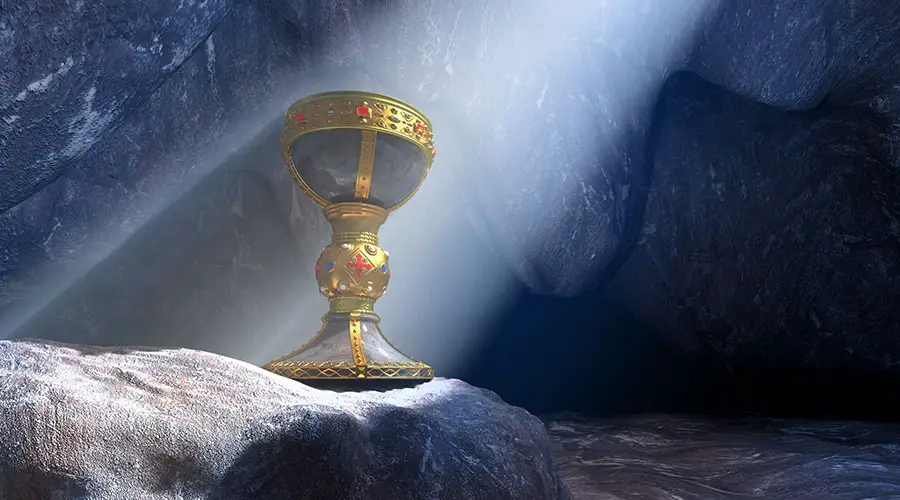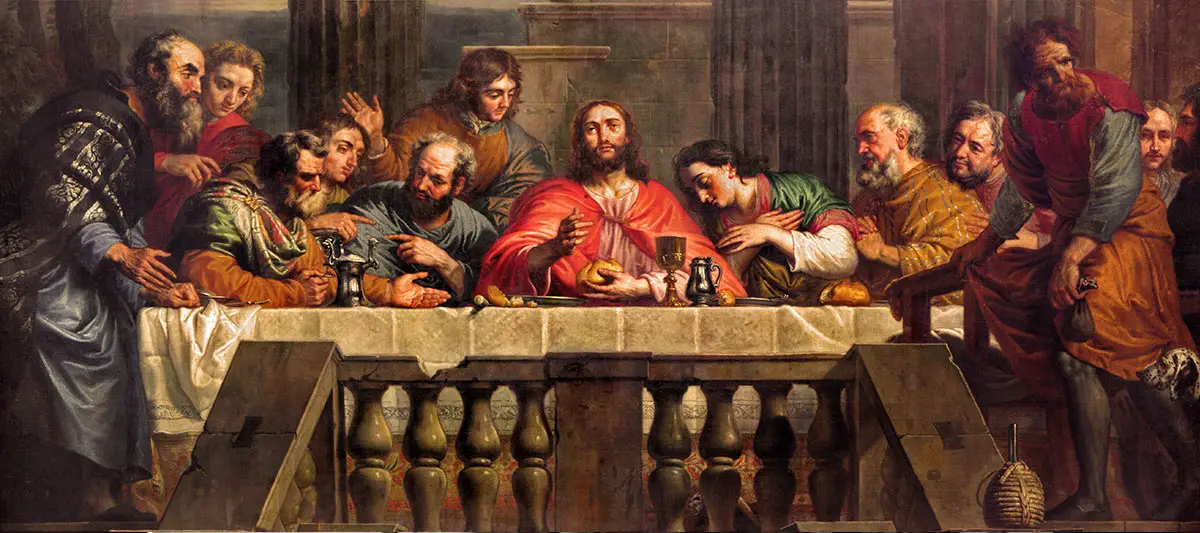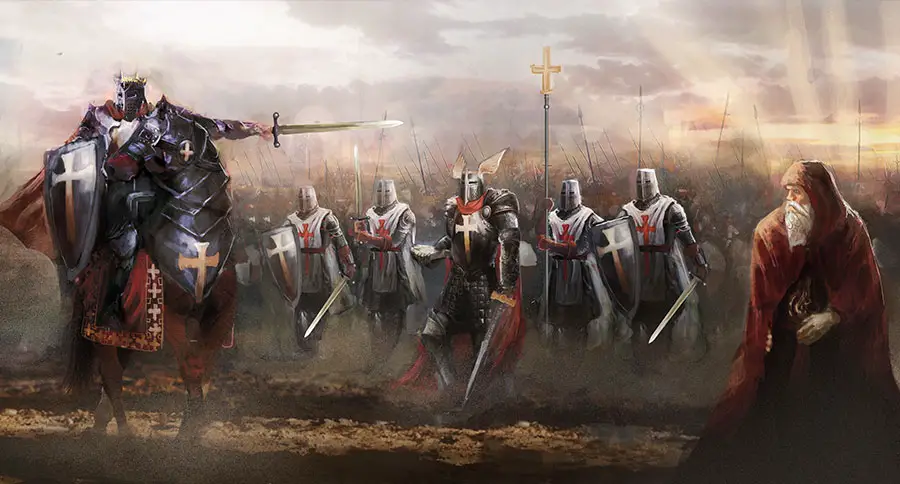Often portrayed as a jewel encrusted chalice, the Holy Grail is an object of mystery and intrigue. But does the Holy Grail really exist? In this article we are going to look at the evidence.
The Holy Grail is not a real historical object, but it is real as an archetypical story that tells us something about the human soul. The legend consists of two parts: that the Holy Grail is the cup that Jesus drank from, and then that it was found by King Arthur’s Knights of the Round Table, in their legendary quest.
But if the Holy Grail isn’t a real historical object, why are there so many claims made that it has been found? And why is there evidence that the Nazis were obsessed with finding it during WWII?

The Holy Chalice of the Last Supper
A big part of why the holy grail is so special is because it was used by Jesus during the Last Supper. The Last Supper is the final meal that Jesus shared with his apostles, before his crucifixion. Leonardo da Vinci famously portrayed this moment in his mural in a church in Milan, Italy during the Renaissance.
The Last Supper is described in the Bible, in Matthew 26:17–29; Mark 14:12–25; Luke 22:7–38; and I Corinthians 11:23–25). It describes Jesus instructing his disciples to prepare a meal. As they meet to eat, he informs them that one of them will betray him. He blesses the bread and wine before his disciples eat, teaching them that it is his body and his blood.
The Holy Grail was also used to collect Jesus’s blood at his crucifixion, by Joseph of Armathea, the man responsible for burying Jesus. It is actually one of several objects taken from the crucifixion, which have talismanic and mystical significance.

True Cross and Holy Lance
During the crucifixion, a blind Roman centurion named Longinus thrust a spear into Jesus’s side in order to confirm that he was dead. Blood from the wound felt out of Jesus’s body and dripped down onto the eyes of Longinus, healing him and allowing him to see. This miracle made Longinus a believer in Jesus.
The spear used is known as the Holy Lance, or also called the Spear of Destiny. It is believed that by possessing it one can access incredible power, including magical abilities such as the ability to summon demons and other beings.
Along with the cup used to collect Jesus’s blood, and the spear that he was stabbed with, the cross that Jesus was nailed to is a magical object of legends. It is called the True Cross, and it is believed to exist in fragments in various grand churches in Europe.
In order for the Holy Grail to be real, we first need to have Jesus existing as a historical figure. What historical evidence is there to support his existence? The earliest known mentions of Jesus are the epistles of St Paul, which are believed to have been written within twenty-five years of his death. The descriptions of the life of Jesus in the New Testament are from about forty years after his death.
Another reference to Jesus comes from the Jewish historian Flavius Josephus in the year 93 AD. He makes passing reference to “Jesus, the so-called Christ” in his book about the history of Judaism. In the 110s AD, the Roman politician Tacitus recounts the time of the execution of Jesus in his records of who was the Emperor and Prefect during that earlier time in history.

The historical records of Jesus are quite thin, and come decades after the time of the crucifixion. Also, there is no archeological evidence that he existed. The supposed remains of the True Cross have been examined using the latest scientific methods in an attempt to place them in the time and place of the crucifixion, but were inconclusive.
Also, if Jesus was a real historical figure, who was able to keep the cup after the crucifixion? Since the cup was used to catch his blood, it was not in the possession of his disciples, and his executioners were probably not interested in collecting memorabilia from the moment.
King Arthur and the Quest for the Holy Grail
The holy Grail also symbolizes the ultimate treasure hunt. It is used as a metaphor whenever the search for something becomes paramount. This idea began to appear in manuscripts in the medieval times, as part of the legend of King Arthur. During The 11th century, the core idea of the story is starts to appear. Over the next few hundred years the legend became more clarified and enriched.
King Arthur became the British King after fulfilling a prophecy by pulling a magical sword from the stone. The sword was called Excalibur, and it had been magically fixed within the stone so that only the one meant to fulfill the prophecy could pull it out. In some versions of the legend, Arthur accidentally pulls it out, not even aware of the prophecy.

In the legend, Arthur has a mentor named Merlin, who is a powerful magician. Originally the counsellor to Arthur’s father, Merlin raises Arthur, who was born in a secret affair. Merlin is present throughout the Arthurian legends, offering advice to Arthur along the way. One of his recommendations to Arthur was to create the Round Table.
King Arthur led a distinguished group of knights, who followed a code of chivalry. In order to have equality amongst his knights, the Round Table was created, so that there would not be differences in status amongst the various seats.
King Arthur and the Knights of the Round Table embarked upon many adventures and battles, uniting the people and being a benevolent and loved king. Arthur’s castle is called Camelot, which represents a golden age. The most important of all of their missions is the search for the Holy Grail.
Despite Arthur’s attempts at creating honour amongst his entourage, Arthur’s wife and his best knight have an affair. Arthur’s wife’s name was Guinevere, and she was the daughter of the King of Scotland. When she married Arthur, she was already in love with Sir Lancelot.
Sir Lancelot and Guinevere secretly have a son together named, Galahad. In some versions of the legend, it is Galahad that is the one who finds the Holy Grail.
When Arthur discovers that his wife and Lancelot have been having an affair, Arthur pursues Lancelot to France. While Arthur is away, his nephew Mordred seizes power, and when Arthur returns the two go to war over the throne. Most of Arthur’s knights are killed, and his sword, Excalibur is thrown in a lake. Arthur is wounded and travels by boat to the magical island of Avalon, where he hopes his wounds will be healed, so that he can return. Because of this, he is sometimes called “the once and future king.”
During the Medieval Ages, many versions of the legend of King Arthur, and the quest for the Holy Grail were written. However, even less evidence exists for King Arthur being historically true, than there is for Jesus. Did the authors of these medieval legends think that they were describing historical events, or where they creating fiction? Certainly, religion played a huge role in their world view. It is difficult to imagine what they were thinking.
Here are some of the most well-known versions of the King Arthur legend from the medieval ages:
Le Conte du Graal
written in the 12th century by French poet Chrétien de Troyes. This book describes the adventures of a knight named Perceval, and introduced the familiar myth around the grail of being a literal adventure, while at the same time having another layer of meaning, a religious quest. While travelling, Perceval catches a brief glimpse of the grail, which leads to him setting out in search of it, and then while searching for it, maturing into a real knight, including chivalry and good behaviour as described by their faith in Christianity.
Morte d’Arthur
French for Death of Arthur, it was written in the 1485 by Sir Thomas Malory. In this version of the legend, the Grail is found by Sir Galahad, the most astute of the King Arthur’s Knights of the Round Table. The story goes that Galahad is able to find it, not because of his combat prowess, but rather because of his piety and chastity, making him worthy of the discovery.

The Fisher King
Another aspect of the King Arthur legend, as it relates to the Holy Grail, is the idea of the Fisher King. There are many variations on the legend, but the essential idea is that after the Knights of the Round Table discover the Holy Grail, there is a bloodline of knights charged with guarding and protecting it. The Fisher King is the latest in this bloodline, but because he is wounded, and incapable of much movement, he spends his time fishing in a small boat near his castle. As his fishes, he waits for the chosen one to come and heal him.
Mary Magdalene and the Merovingian Dynasty
Another aspect of the mythology around the Holy Grail, is the idea of the Merovingian bloodline, which is the theory that Jesus and Magdalene had children, and their descendants are still alive today, perhaps in France. In this version, the Holy Grail is the womb of Magdalene, and emphasis is placed on blood of Jesus and the unique genetic attributes it possesses.
According to this legend, an organization named the Priory of Sion was created in 1099 AD, and is devoted to restoring the Merovingian dynasty. This secret organization had illustrious Grand Masters including Leonardo da Vinci and Isaac Newton. The Priory created the Knights Templars to deal with financial and military matters.
The Holy Grail and the Knights Templars
The Knights Templars came into existence over 700 years ago, and protected Christian pilgrims travelling to the Holy Land. They became more powerful over time as they amassed land and wealth, fighting in the crusades. They were also rumoured to have possessed the Holy Grail, after finding it in Jerusalem. Officially the group came to an end on Friday the 13th, 1307, when the King of France ordered them executed for treason. That is where the idea of Friday the 13th originally comes from. Many believe that the Knights Templars continue to exist today, operating as a secret organization. If they do in fact exist today, in order to have any kind of insight into their secret records and history, one would have to be initiated into their organization.

The Nazis and the Holy Grail
There is no consensus on the extent that the Nazi movement that occurred in the 1920s to 1940s in Germany was influenced by occultism. Some say that it has been blown totally out of proportion, and perhaps a few aesthetic ideas were borrowed, but that’s about it. Others say that the entire movement was so occult that in effect it was powerful forces from the spirit realm conducting the whole thing.
The occult influence of the Nazis came from a group called the Thule Society. They were founded in Munich after WW1 as an occult organization, and founded the German Worker’s Party, which led to the rise of Hitler. Most of the highest ranking Nazi officers were also members of the Thule Society.
Much of it is speculation, but there is evidence that the Nazis were in fact searching for the Holy Grail, as well as conducting other occult activities.
An SS unit called the Ahnenerbe (Ancestral Heritage) that was responsible for the recovery of artifacts they considered essential. Rumours abound that they were searching for the Holy Grail, as well as the Spear of Destiny, remains of the lost civilization of Atlantis and the Ark of the Covenant. Nazi soldiers were seen during WWII in Ethiopia, searching for the Ark of the Covenant. Also, they made mysterious missions to Antarctica, perhaps related to their interest in Atlantis.
If the Nazis were in fact searching for the Holy Grail before and during WWII, they must have believed it existed. Why would they use precious resources, during a very close war that they eventually ended up losing, if they were not totally convinced that, not only were these magical artifacts real, but by possessing them would give them powers that could be used to their advantage in the war?
Popular Theories of the Holy Grail’s Location
Another strange aspect of the Holy Grail legend is that from time to time, reputable academics will make sincere claims that they have found the real Holy Grail. These are usually incredible chalices, covered in exquisite jewels, and it is hard to imagine Jesus drinking out of something so ostentatious. Some of these incredible chalices are on display in various museums in Europe, especially in Spain.
Recommended Reading
If you want to continue exploring this subject more deeply, you can see which books I recommend by clicking here.

